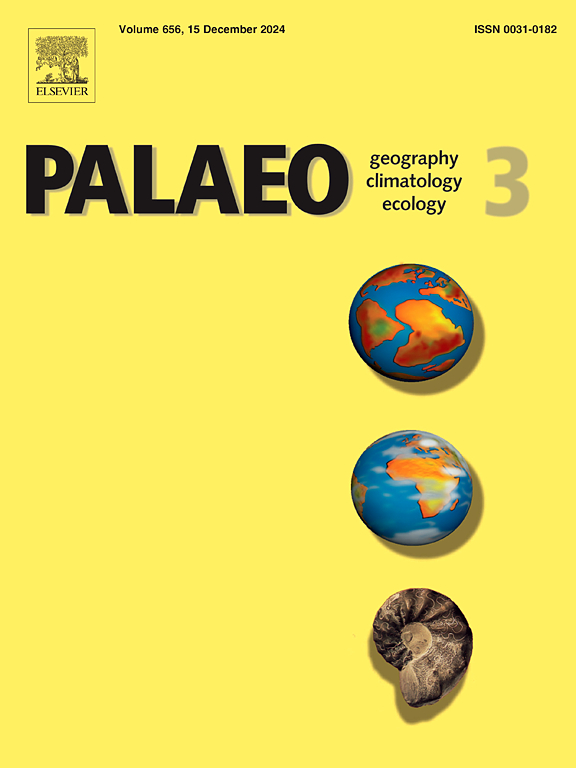近200年来中国西北旱地湖泊生态系统的长期生物响应与人为影响
IF 2.7
2区 地球科学
Q2 GEOGRAPHY, PHYSICAL
Palaeogeography, Palaeoclimatology, Palaeoecology
Pub Date : 2025-05-31
DOI:10.1016/j.palaeo.2025.113075
引用次数: 0
摘要
近几十年来,由于气候变暖的加速和人类活动的加剧,中亚干旱湖泊发生了严重的生态环境变化。然而,整合多群落动态、长期历史趋势和生态变化驱动因素的研究很少,限制了我们有效管理这些淡水生态系统演变的能力。本文分析了博斯腾湖和艾利克湖近两个世纪的高分辨率生物指标(亚化石支海动物和硅藻),并与该地区其他湖泊的记录进行了比较,以揭示湖泊生态系统的变化。我们的研究结果表明,在这些旱地湖泊中,自然气候变率是第一次转变(~ 1910 CE)的主要驱动因素,而人为强迫主要驱动了第二次转变(~ 1960 CE)。公元1960年以后,浮游富营养化枝海洋物种,如长尾藻和硅藻物种,包括Fragilaria c.c ortonensis、Cyclotella atomus和Cyclotella meneghiniana,变得更加占优势。冗余分析和方差划分分析表明,群落组合的变化主要受氮负荷(TN和/或δ15N)驱动,湖泊生产力(Chl-a和TOC)和全球变暖也有影响。此外,从公元1990年开始,博斯腾湖的进化纲海洋组成发生了另一种变化,从大型水蚤到小型水蚤,这可能是由于引入商业养鱼而增加的捕食压力造成的。我们的研究结果强调了理解湖泊生态变化与气候和人为压力的复杂相互作用对于可持续水资源管理战略、增强生态恢复力和保护淡水生态系统免受进一步退化的重要性。本文章由计算机程序翻译,如有差异,请以英文原文为准。
Long-term biotic responses and anthropogenic impacts in dryland lake ecosystems of northwestern China over the past two centuries
In recent decades, lakes in arid central Asia have undergone severe ecological and environmental changes due to accelerated climate warming and intense human activities. However, there have been few studies that integrate multi-community dynamics, long-term historical trends, and drivers of ecological change, limiting our ability to effectively manage the evolution of these freshwater ecosystems. In this paper, we analyze high-resolution biotic proxies (subfossil cladocerans and diatoms) from Bosten Lake and Ailike Lake, northwest China, over the past two centuries, and compare these records with other lakes in the region to reveal changes in lake ecosystems. Our results indicate that natural climate variability was the primary driver of a first transition (∼1910 CE), whereas anthropogenic forcings predominantly drove a second transition (∼1960 CE) in these dryland lakes. After ∼1960 CE, planktonic eutrophic cladoceran species such as Bosmina longirostris and diatom species including Fragilaria cf. crotonensis, Cyclotella atomus, and Cyclotella meneghiniana became more dominant. Redundancy analysis and variance partitioning analysis suggest that changes in community assemblages were mainly driven by nitrogen loading (TN and/or δ15N), with additional influences related to lake productivity (Chl-a and TOC) and global warming. Furthermore, another shift in cladoceran composition in Bosten Lake, commencing ∼1990 CE, from large-sized Daphnia to small-sized Bosmina, was likely caused by increased predation pressure as result of the introduction of commercial fish farming. Our findings highlight the importance of understanding the complex interactions of lake ecological shifts with compounded stressors, both climate and anthropogenic forcings, for sustainable water management strategies, enhancing ecological resilience, and protecting freshwater ecosystems from further degradation.
求助全文
通过发布文献求助,成功后即可免费获取论文全文。
去求助
来源期刊
CiteScore
5.90
自引率
10.00%
发文量
398
审稿时长
3.8 months
期刊介绍:
Palaeogeography, Palaeoclimatology, Palaeoecology is an international medium for the publication of high quality and multidisciplinary, original studies and comprehensive reviews in the field of palaeo-environmental geology. The journal aims at bringing together data with global implications from research in the many different disciplines involved in palaeo-environmental investigations.
By cutting across the boundaries of established sciences, it provides an interdisciplinary forum where issues of general interest can be discussed.

 求助内容:
求助内容: 应助结果提醒方式:
应助结果提醒方式:


